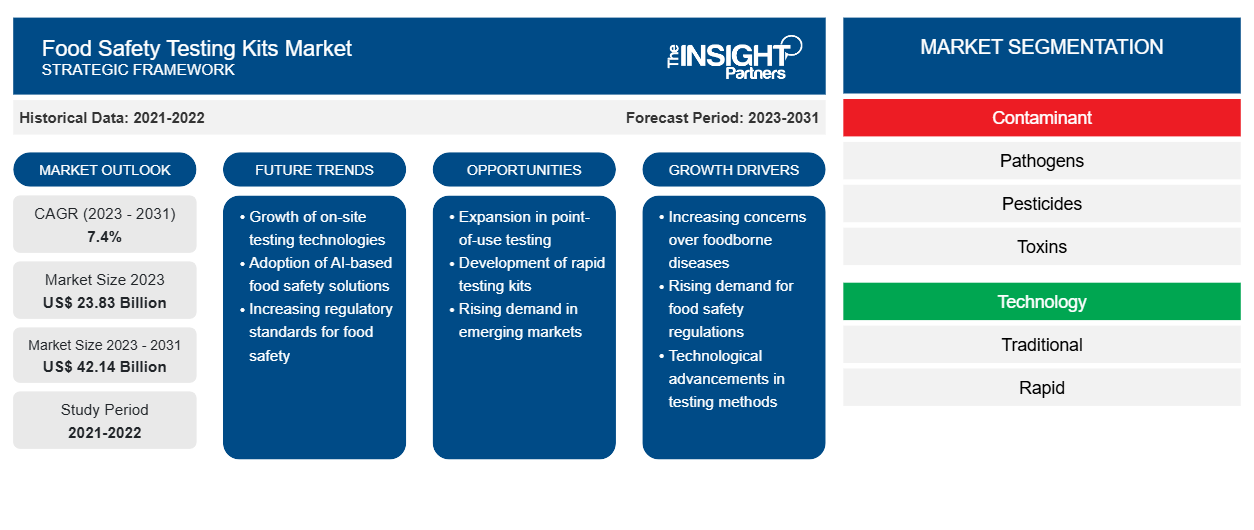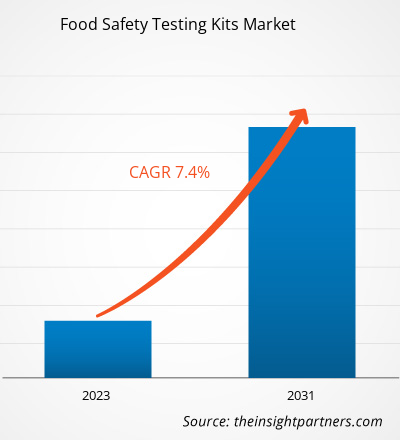The Food Safety Testing Kits Market size is projected to reach US$ 42.14 billion by 2031 from US$ 23.83 billion in 2023. The market is expected to register a CAGR of 7.4% in 2023–2031. Significantly growing food & beverages industry is likely to remain key food safety testing kits market trends.
Food Safety Testing Kits Market Analysis
All antibiotics and other antimicrobials are used to treat infections caused by bacteria. The misuse and overuse of antimicrobials in human and veterinary medicine has been linked to the emergence of resistant bacteria rendering the treatment of humans and animals ineffective. Antimicrobial medicine is identified as one of the biggest threats to modern medicine. Therefore, it has become extremely important to detect the contaminants beforehand and prevent them from entering the food chain. Thus, the importance of food safety testing kits has been increasing globally in terms of volume. Moreover, the decline in food service demand for oilseeds and grains harmed sales during 2020, the reopening of global foodservice platforms and higher selling prices is expected to boost the food safety testing kits market growth over the forecast period.
Food Safety Testing Kits Market Overview
Food safety testing is a scientific analysis of a food product and its contents to find information about various characteristics such as physiochemical properties, composition, and structure. The information is used to determine the safety of the product for consumption. The rising prevalence of foodborne illnesses demands food safety testing for all food and beverage products to prevent health hazards, which boosts the growth of the food safety testing kits market.
Customize This Report To Suit Your Requirement
You will get customization on any report - free of charge - including parts of this report, or country-level analysis, Excel Data pack, as well as avail great offers and discounts for start-ups & universities
Food Safety Testing Kits Market: Strategic Insights

-
Get Top Key Market Trends of this report.This FREE sample will include data analysis, ranging from market trends to estimates and forecasts.
Food Safety Testing Kits Market Drivers and Opportunities
Ascension of Global Food and Beverage Industry to Favor Market
The food and beverages industry is all companies involved in distributing, packaging, and processing of food materials. This includes non-alcoholic beverages, alcoholic beverages, packaged foods, and fresh foods. Almost all products meant for human consumption, excluding pharmaceutical products, are included in this industry. The food and beverage industry is becoming increasingly focused on mechanical manipulation and technology to create more value-added products. Moreover, with population growth and rising middle class in developing countries, the demand for variety of food products is increasing. Thus, with growing food & beverage industry driving the food safety testing kits market growth.
Rising Milk Consumption – An Opportunity in Food Safety Testing Kits Market
The dairy sector is one of the most vulnerable sectors to foodborne illnesses as dairy products harbor a variety of microorganisms. As pasteurization may not destroy all pathogens in milk, testing of milk becomes essential to ensure safety. Milk is also one of the products that is consumed daily in large quantities all over the world. Thus, the high milk consumption leads to a higher volume of food safety testing kits driving the market further.
Food Safety Testing Kits Market Report Segmentation Analysis
Key segments that contributed to the derivation of the food safety testing kits market analysis are contaminants, technology, and food type.
- Based on contaminants, the food safety testing kits market is divided into pathogens, pesticides, toxins, GMOs, and others. The pathogens segment is further sub-segmented into Salmonella, E. coli, Listeria, Campylobacter, S. aureus, and others. Pathogen segment held a larger market share in 2023.
- Based on technology, the market is bifurcated traditional and rapid. The rapid segment is categorized into PCR-based testing, immunoassay-based testing, LAMP, and others.
- In terms of application, the market is segmented into meat, poultry, & seafood products; dairy products; cereals & grains; processed food; fruits & vegetables; and others. The meat, poultry, & seafood products segment dominated the market in 2023.
Food Safety Testing Kits Market Share Analysis by Geography
The geographic scope of the food safety testing kits market report is mainly divided into five regions: North America, Asia Pacific, Europe, Middle East & Africa, and South America/South & Central America.
The food safety testing kits market in North America is significantly In North America, the food safety testing kits market is currently in the growth phase and experiencing exponential growth. North America is a major hub for food processing. According to the US Food and Drug Administration (FDA), 99,451 domestic food facilities were registered as of September 2022, in the US. Countries in North America have strict regulatory bodies pertaining to food safety the high quantity of food processing in the region is expected to affect the food safety testing kits market growth positively.
Food Safety Testing Kits Market Regional InsightsThe regional trends and factors influencing the Food Safety Testing Kits Market throughout the forecast period have been thoroughly explained by the analysts at The Insight Partners. This section also discusses Food Safety Testing Kits Market segments and geography across North America, Europe, Asia Pacific, Middle East and Africa, and South and Central America.
Food Safety Testing Kits Market Report Scope
| Report Attribute | Details |
|---|---|
| Market size in 2023 | US$ 23.83 Billion |
| Market Size by 2031 | US$ 42.14 Billion |
| Global CAGR (2023 - 2031) | 7.4% |
| Historical Data | 2021-2022 |
| Forecast period | 2023-2031 |
| Segments Covered |
By Contaminant
|
| Regions and Countries Covered |
North America
|
| Market leaders and key company profiles |
|
Food Safety Testing Kits Market Players Density: Understanding Its Impact on Business Dynamics
The Food Safety Testing Kits Market is growing rapidly, driven by increasing end-user demand due to factors such as evolving consumer preferences, technological advancements, and greater awareness of the product's benefits. As demand rises, businesses are expanding their offerings, innovating to meet consumer needs, and capitalizing on emerging trends, which further fuels market growth.

- Get the Food Safety Testing Kits Market top key players overview
Food Safety Testing Kits Market News and Recent Developments
The food safety testing kits market is evaluated by gathering qualitative and quantitative data post primary and secondary research, which includes important corporate publications, association data, and databases. The following is a list of developments in the market for innovations, business expansion and strategies:
- In May 2021, Eurofins Food and Water Testing UK & Ireland announced the acquisition of Alliance Technical Laboratories (ATL) Ltd. The acquisition will improve the company’s food, water, and feed testing service provision in the Southeast and is part of its planned strategic growth agenda. (Source: Eurofins, Press Release)
- In June 2021, SGS announced the opening of its new food testing laboratory in Papua New Guinea. The new laboratory offers internationally recognized quality testing to the food manufacturing, hospitality, and retail market segments. The facility offers a wide range of testing services, such as food microbiology indicators, food microbiology pathogens, water microbiology, and water chemistry. (Source: SGS, Newsletter)
Food Safety Testing Kits Market Report Coverage and Deliverables
The “Food Safety Testing Kits Market Size and Forecast (2021–2031)” report provides a detailed analysis of the market covering below areas:
- Market size and forecast at global, regional, and country levels for all the key market segments covered under the scope
- Market dynamics such as drivers, restraints, and key opportunities
- Key future trends
- Detailed PEST/Porter’s Five Forces and SWOT analysis
- Global and regional market analysis covering key market trends, major players, regulations, and recent market developments
- Industry landscape and competition analysis covering market concentration, heat map analysis, prominent players, and recent developments
- Detailed company profiles
- Historical Analysis (2 Years), Base Year, Forecast (7 Years) with CAGR
- PEST and SWOT Analysis
- Market Size Value / Volume - Global, Regional, Country
- Industry and Competitive Landscape
- Excel Dataset
Recent Reports
Related Reports
Testimonials
Reason to Buy
- Informed Decision-Making
- Understanding Market Dynamics
- Competitive Analysis
- Identifying Emerging Markets
- Customer Insights
- Market Forecasts
- Risk Mitigation
- Boosting Operational Efficiency
- Strategic Planning
- Investment Justification
- Tracking Industry Innovations
- Aligning with Regulatory Trends





















 Get Free Sample For
Get Free Sample For